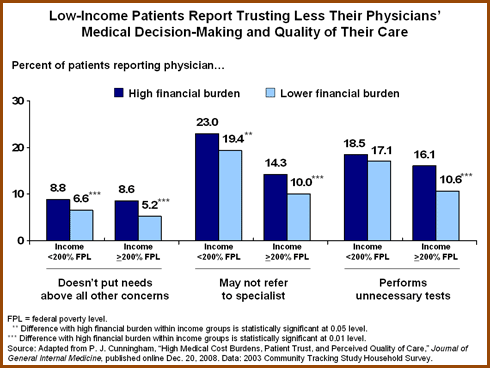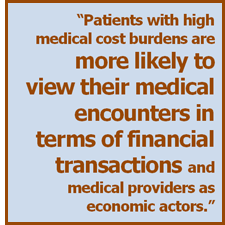An abstract is available at:
www.springerlink.com/content/783702n1233j8110/
Synopsis
Patients with higher medical costs have less faith in their physician's medical decision-making and more negative assessments of the quality of care they receive.

The Issue
As health care costs continue to rise faster than inflation, many Americans are facing increasing financial burdens. Public opinion polls suggest growing dissatisfaction with the health care system overall as out-of-pocket costs climb. This study examined the implications of rising health care costs on patients' trust in their physicians. Lack of trust in physicians is known to compromise patients' willingness to seek care and adhere to treatment recommendations.
Key Findings
- Overall, 27 percent of U.S. adults with a regular source of care are in families with high medical cost burdens. Eighteen percent of respondents have high out-of-pocket costs relative to income and 14 percent have problems paying their medical bills.
- Proportionately more uninsured adults have a high medical cost burden (40%) compared with patients with private or public insurance (25% or less).
- About 6 percent of all patients do not believe their physician puts their needs above all concerns, and 13 percent and 14 percent, respectively, believe their physician may perform unnecessary tests or fail to refer them to a specialist.
- In general, people with high medical cost burdens are more likely than people without high burdens to lack trust in medical decision-making and to provide negative assessments of their encounters with physicians. Differences were somewhat larger among higher-income respondents.
- The negative association between high medical cost burdens, patient trust, and perceived quality of care is more concentrated among privately insured people.
Addressing the Problem
 The results of this survey suggest that patients with higher medical costs may believe that physicians are more interested in financial gain than in providing appropriate and necessary services, say the authors. Efforts to strengthen the patient–physician relationship by focusing on providing patient-centered care through a medical home may help improve patient trust, but they may not be enough to overcome the negative consequences of high cost burdens. With out-of-pocket expenses increasing for U.S. families—particularly those enrolled in private high-deductible health plans—researchers and policymakers need to learn more about the effects that high medical cost burdens have on the patient–physician relationship.
The results of this survey suggest that patients with higher medical costs may believe that physicians are more interested in financial gain than in providing appropriate and necessary services, say the authors. Efforts to strengthen the patient–physician relationship by focusing on providing patient-centered care through a medical home may help improve patient trust, but they may not be enough to overcome the negative consequences of high cost burdens. With out-of-pocket expenses increasing for U.S. families—particularly those enrolled in private high-deductible health plans—researchers and policymakers need to learn more about the effects that high medical cost burdens have on the patient–physician relationship.
About the Study
The study analyzed data from the 2003 Community Tracking Study Household Survey, which included 32,210 adults who reported having a physician as their regular source of care. Respondents with a high medical cost burden included those with high out-of-pocket medical costs relative to their incomes and/or problems paying medical bills. Participants answered questions regarding whether they thought their physician put patients' needs first, the likelihood that their physicians would refer patients to a specialist when needed, and the likelihood of prescribing unnecessary tests. The survey also sought to measure patients' perceptions of quality, including the thoroughness of exams and physicians' listening and communication skills.
The Bottom Line
Exposing patients to a larger share of health care costs could lead to greater skepticism and less trust in physicians' decision-making, with potentially negative consequences for the effectiveness of health care delivery.